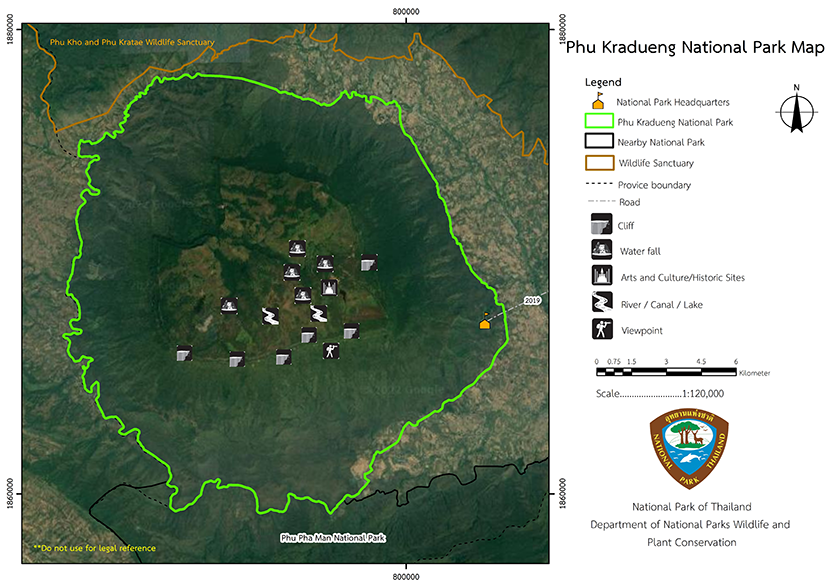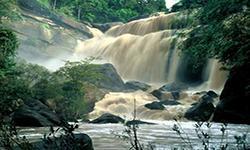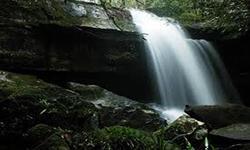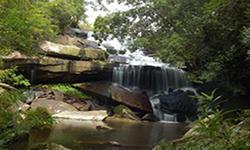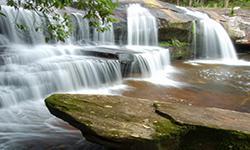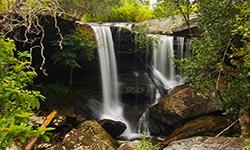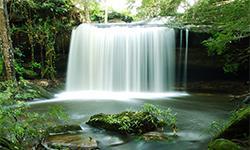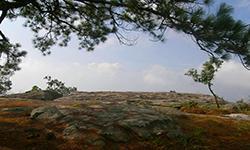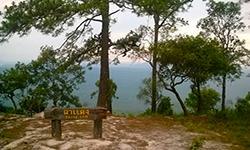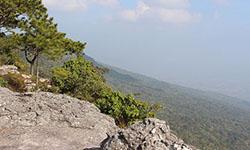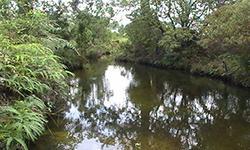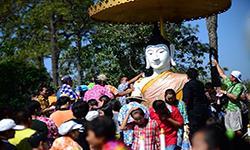Phu Kradueng National Park
Contact Location : Phu Kradueng National Park,Moo.1, Ban Si Than, Si Than Sub-district, Phu Kradueng District, Loei Province 42180.
Telephone Number :(+66) 4 281 0833,(+66 ) 4 281 0834 (Book a villa)
Email : pkd_11@hotmail.co.th
Facebook : Phu Kradueng National Park
Information
-
Background
Phu Kradueng National Park was declared as Thailand 's second national park on November 23, 1962. It is located in Si Than Sub-district, Phu Kradueng District, Loei Province, covering an area of 348.13 square kilometers (217,576.25 Rai). The topography is a sandstone mountain top cut with a plain on the top of Phu Kradueng, about 60 square kilometers (37,500 rai) Phu Kradueng has an elevation of between 400 – 1,200 meters above mean sea level. The highest point is in the Khok Moei area, at a height of 1,316 meters above mean sea level. The general conditions of Phu Kradueng consists of various plants, various wildlife species, cliffs, grasslands, streams, and waterfalls, and it is also the watershed area of the Phong stream, which is one of the important rivers in the Northeast. With altitude, atmosphere, the weather is therefore cool all year round on the top of Phu Kradueng, especially in winter, when the temperature may drop as low as 0 degrees Celsius, thus motivating visitors to conquer the summit of Phu Kradueng once in their lives.
Visitors who wish to travel and stay at the top of Phu Kradueng should inquire or reserve the service in advance for both tents provided by the national park and camping areas for tourists who bring their own tents before traveling to Phu Kradueng National Park, calling at number 0-4281-0833 and number 0-4281-0834 (during office hours).
Note : After paying the entrance fee to the National Park, please carry the receipt for inspection.
217,576.25 rai (348.122 square kilometers)
|
|
|
||
|
Tham Yai Waterfall |
Than Sawan Waterfall |
||
|
Phon Phop Waterfall |
Phen Phop Waterfall |
||
|
Phen Phop Mai Waterfall |
Wang Kwang Waterfall |
||
|
Pha Cham Sin |
Pha Daeng |
||
|
Pha Nok Aen |
Pha Na Noi |
||
|
Pha Mak Duk |
Pha Lom Sak |
||
|
Pha Yiap Mek |
Sa Kaeo |
||
|
Anodat Pond |
Prasinakarin yard (Bodh gaya buddha) |
||
-
Welfare shop : not available
Mobile phone signal :
1. National Park Headquarters: AIS, TRUE, DTAC
2. Phu Kradueng National Park area at the top of the mountain: AIS, TRUE
|
|
The general condition of Phu Kradueng National Park: It is a sandstone mountain in the northwest of the Khorat Plateau. It is near the eastern part of the slope of the Phetchabun Mountains. The geological structure of Phu Kradueng originated in the Mesozoic era, belonging to the Khorat Group which is composed of Phu Phan Formation, the Sao Khua Formation, the Phra Wihan Formation, and the Phu Kradueng Formation. Most of the mountains are at an altitude of between 400-1,200 meters above mean sea level, with a flat area on the top of the mountain that resembles an Elephant Ear's leaf, consisting of low hills. The highest peak is Khok Moei, approximately 1,316 meters above mean sea level. The flat area on the top of Phu Kradueng is high in the west and southeast. The area gradually slopes down to the northwest, causing various stream caused by water sources on the mountain flowing together on this side. It is the source of the Phong Stream, which nourishes Ubol Ratana Dam and Nong Wai Dam in Khon Kaen Province. Water Resources |
|
The climate of a low-level area along the foothills of Phu Kradueng National Park. The conditions are generally similar to other areas of the Northeast, influenced by the southwest monsoon and the northeast monsoon. The rainy season runs from April to October. The heaviest rainfall occurs between August and September. The annual average temperature is 26 degrees Celsius, with the lowest temperature in January and the highest temperature in April. The general weather conditions on Phu Kradueng Peak are very different from the weather in the low plains. The rainfall will increase by approximately 30% of the amount currently falling in the lowlands. Due to the influence of clouds/fog that always cover Kradueng, from December to January, the average minimum temperatures is between 0-10 degrees Celsius, and an average maximum temperature is between 21-24 degrees Celsius. The summer runs from March to April. The average minimum temperature is between 12-19 degrees Celsius, and the average maximum temperature is between 23 - 30 degrees Celsius. The weather on the Phu Kradueng summit is often fluctuating, often covered with low clouds. The weather is therefore quite cool all year round. During the rainy season, there are often natural disasters such as erosion of mountains and runoff |
|
|
|
|
The plant community of Phu Kradueng is one of the most fertile forests. There are both deciduous and evergreen forests at different heights, which can be classified as follows: Mixed deciduous forests can be found on the piedmonts and on the slopes along the mountainside around Phu Kradueng at an altitude of about 950 meters above mean the sea. Important plants include as Xylia xylocarpa, Pterocarpus macrocarpus, Irvingia malayana, Terminalia corticosa, Chukrasia tabularis , Spondias cytherea, Bombox anceps, Cassia garrettiana, Afzelia xylocarpa, Garuga pinnata, Terminalia chebula, Sterculia foetida, Wrightia arborea, etc. The undergrowth plants consist of grasses and bamboos such as Thyrsostachys siamensis, Gingantochloa albociliata, Bambusa vulgarisand Dendrocalamus strictus Shrubs such as Harrisonia perforata, Leea indica, Crossandra infundibuliformis Dendrocalamus latiflorus, etc. Climbers inlucde Pterolobium intergrum Craib, Desmos chinensis, Uvaria dulcis Dunal, Getonia floribunda, Stemona tuberosa, Dioscorea hispida, etc. Herbaceous plants include Amorphophallu soncophyllus, Commelina benghalensis, Murdannia spectabilis, etc. Parasitic plants and epiphytic plants include Aeginetia indica Roxb, Zingiber thorelii Gagnep Platycerium holtumii, etc. Dry evergreen forest can be found along the banks of moist valleys in the eastern part, northeast and west from the foothills to an altitude of about 950 meters above mean sea level. The important plant species are Castanopsis spp, Hopea odorata, Dipterocarpus turbinatus, Toona ciliata, Lagenstroemia duperreana, Syzygium cumini, Mangifera caloneura, Alstonia scholaris, Artocarpus lacucha, Nephelium hypoleucum , Cinnamomum iners, etc. Dense undergrowth plants are shrubs and vines such as Thunbergia grandiflora, Celastrus paniculatus, Urceola minutiflora, Hill Evergreen forests are found at 1,000 meters above mean sea level in the north and northwest. Important plants include Acer calcaratum Gagnep, Schima wallichii, Dacrydium elatum, Calophyllum thorelii Pierre, Paramichelia baillonii, Podocarpus neriifolius, Castanopsis echinocarpa, Castanops tribuloides, Lithocarpus bennettii, Dillenia suffruticosa, Calotropis gigantea, Heliciopsis terminalis Sleum, Carallia brachiata, Garcinia speciosa, Meliosma simplicifolia, etc. The lower ground plants consist of shrubs such as red roses, Schefflera heptophylla, Strobilanthes cusia Peristrophe lanceolaria, etc. Tall palm trees grow at a distance from one another along the cliffs at the edge of the mountain including Trachycarpus oreophilus and climbers such as Vitex siamica, Tetrastigma leucostaphyllum, Mussaenda sanderiana, Rubus rugosus., Stephania glandulifera, Plectranthus amboinicus, et. The pine forest is found only on the phu Kradueng plains at an altitude of about 1,200-1,350 meters above mean sea level. Important plants include Pinus merkusii., Quercus aliena Blume, Schima wallichii, Anneslea fragrans, Diospyros malabarica, Gluta usitata, etc. Ground cover plants consist of Baeckea frutescens, Vaccinium sprengelii, Rhododendron microphyton, Lyonia ovalifolia, Ardisia Pilosa, Curcuma aromatica, etc. On the stone courtyard, there are unicellular plants such as two types of lichens, lichen attaching to the stone slabs and rock foam lichen , covering in general. Additionally, there are Eria lasiopetala, Phalaenopsis pulcherrima and Phalaenopsis cornu-cervi, which is an orchid growing in a dense clump. Herbaceous plants found include Marigold, Gerbera piloselloides, Duhaldea nervosa, Typha angustifolia, Torenia fournieri, Burmannia disticha, Nephrolepis exaltata Schott, Aeschymanthus Hildebrandii, Caulokaempferia thailandica, Gentiana hesseliana, Pavo muticus, Exacum tetragonum, Nepenthes smilesii, Pteridium aquilinum, etc. On the wet ground various types of moss, such as Calanthe triplicata, is densely piled up, like a carpet. In some places, there are many types of small herbaceous plants such as Eriocaulon henryanum, Uticularia aurea, Utricularia delphinioides, and Burmannia disticha. Phu Kradueng is known as a source of an abundant wildlife because the topography consists of forests, grasslands and streams which are a rich food source. There are many types of wildlife in the Phu Kradueng Forest, including Wild Elephants, Indian Muntjac, Sambar Deer, Wild Boar, Pig-tailed Macaque, Slow Lorises, Sunda flying Lemur, Finlayson’s Squirrel, Chipmunk, Ryukyu Mouse, Kloss’s Mole, Asian brush–tailed Porcupine, Small Asian Mongoose, Common Palm Civet, Crested Serpent-eagle, Green pigeons, Spotted Dove, greater coucal, Collared Scops Owl, Indochinese Roller, Blue-throated Barbet, Coppersmith Barbet, common flameback, Red-rumped Swallow, Olive-backed Pipit, White Wagtail, Large Cuckooshrike, Chinese Francolin, Scarlet Minivet, White-rumped Shama, Puff-throated Babbler, Old World oriole, Tokay gecko, Hemidactylus platyurus Schneider, Calotes mystaceus, Many-lined Sun Skink, Elongated tortoise, Copper-head Trinket Snake, Xenochrophis flavipunctatus, King Cobra, Cobra, Sumatran Green Pit Viper, Spotted narrow-mouthed frog, Rana limnocharis, Toads, American bullfrog, Dwarf Bushfrog, And there is one type of rare turtle that is Siamese Big-headed Turtle or Snaped Turtle; It is a long-tailed turtle that Lives along the streams in the high-altitude forests of Thailand, Cambodia, and Laos. |
How to get there by car :
1) Pass through Saraburi Province, Phetchabun Province, Lom Sak, Lom Kao, Dan Sai, Phu Ruea and Mueang Loei Districts. Turn onto National Highway No. 201 (Loei-Khon Kaen) and turn onto the road No. 201 heading to Phu Kradueng National Park
2) Take the path through Saraburi Province, Nakhon Ratchasima and Khon Kaen Province. Turn left onto National Highway No. 201, passing through Phu Pha Man and Pha Nok Khao District, heading to Phu Kradueng National Park.
3) Travel through Saraburi Province, Pak Chong District, turn left onto National Highway No. 201, passing through Chaiyaphum Province, Phu Khieo District, and then turn left onto National Highway No. 12, passing through Chum Phae District, then travel the same way as Route No. 2
How to get there by airplane
using flights between Bangkok-Khon Kaen, Bangkok-Loei, and Bangkok-Udon Thani of various airlines every day. For flight and airline information, call 0-2628-2000, 0-2515-9999, 0-2267-2999, or 1318.
How to get there by train
Take the train from Hua Lamphong Railway Station to Khon Kaen Railway Station. Take the Khon Kaen-Loei bus to Phu Kradueng District and then take a minibus to Phu Kradueng National Park. For information on train schedules,
Tel. 0-2225-1300 ext. 5201, 0-2223-0341-3 or contact directly at Kradueng National Park
Tel. 0-4281-0833, 0-4281-0834
How to get there by public bus
Take the Bangkok-Mueang Loei route bus at the northeast bus terminal (at Mo Chit 2 Bus Terminal) and get off at Pha Nok Khao or Phu Kradueng Bus Station. Then continue by Songtaew or minibus, heading to Phu Kradueng National Park. Inquire about bus information by calling 0-2936-2852-66
Fares:
24-seater VIP air-conditioned car, price 590 baht/VIP 32-seater air-conditioned car, price 449 baht.
Air-conditioned car, 1st Class Bus, price 258 baht/air-conditioned car, 2nd floor, price 280 baht. Get off the bus at Pha Nok Khao.
*Note-Take a minibus from Pha Nok Khao to Phu Kradueng National Park. The price is 30 baht/person.
- National Park Ranger Station Lo Yo No. 1 (Wang Kwang)
- National Park Ranger Station Lo Yo No. 4 (Phong Neb)
- National Park Ranger Station Lo Yo No. 2 (Ealert)
- National Park Ranger Station Lo Yo No. 5 (Nong Phakbung)
- National Park Ranger Station Lo Yo No.3 (Na Noi)
- National Park Ranger Station Lo Yo No. 6 (Phu Khi Kai)
- Accommodation - Phu Kradueng 106 (Suphannika)
- Accommodation - Phu Kradueng 107 (Song Badan)
- Accommodation - Phu Kradueng 1 08 (Sai Nam Phueng)
- Accommodation - Phu Kradueng 109 (Lamduan Dong)
- Accommodation - Phu Kradueng 110/1-5 (Tiannam)
- Accommodation - Phu Kradueng 111/1-4 (Yat Nam Khang)
- Accommodation - Phu Kradueng 201/1,2 (Phaka Krong)
- Accommodation – camping ground
- Accommodation – Phu Kradueng 105 (Amphawa)
- Accommodation - Phu Kradueng 104 (Saliam Dong)
- Accommodation - Phu Kradueng 204 (Si Than 3)
- Accommodation – Big Dome Tent and Big Cabin Tent
- Accommodation – Platform Tent
- Accommodation – sleeping bags
- Accommodation – mattresses
- Accommodation – pillows
- Accommodation - Phu Kradueng 103 (Ban Kulap Khao)
- Accommodation - Phu Kradueng 202 (Si Than 1)
- Accommodation - Phu Kradueng 203 (Si Than 2

